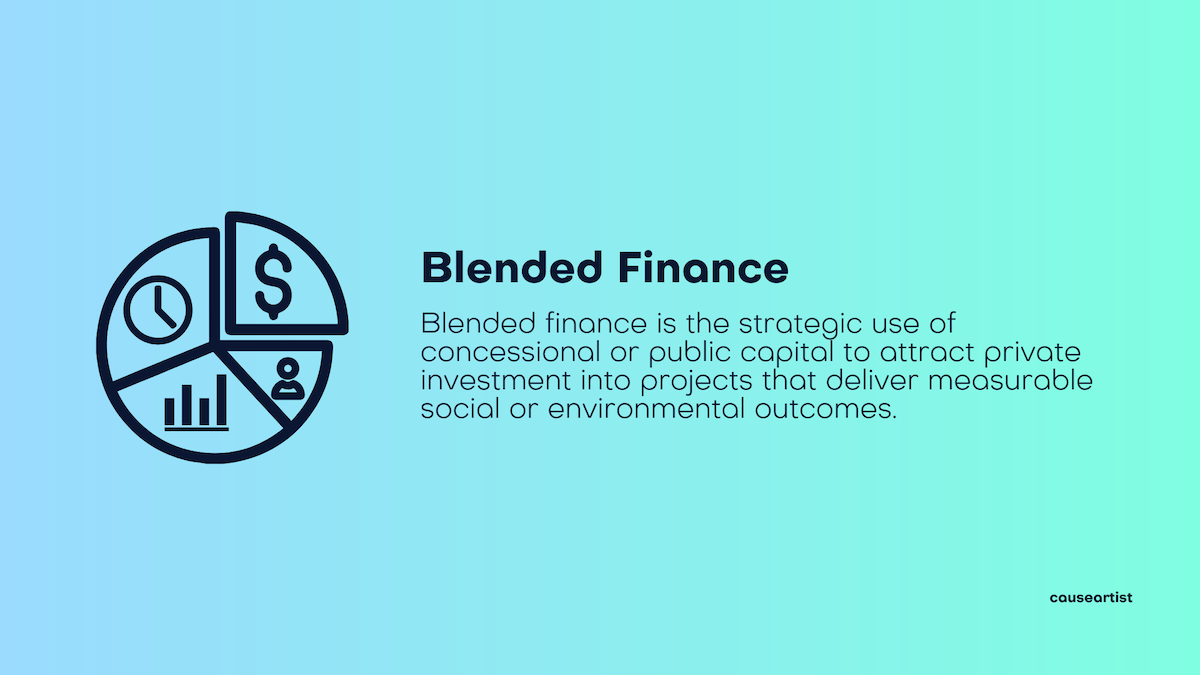Blended finance is the strategic use of concessional or public capital to attract private investment into projects that deliver measurable social or environmental outcomes. In simple terms, it uses lower-cost funding from governments or foundations to reduce risk for commercial investors.
This mix of capital enables projects in emerging markets or underserved sectors to secure financing that meets both impact and profitability goals.
For example, a foundation might provide a first-loss guarantee, while private investors fund the majority of a renewable energy project.
How Blended Finance Works
At its core, blended finance relies on capital layering and risk sharing. Each participant contributes according to their strengths:
- Public and philanthropic investors supply concessional funding, grants, or guarantees to make projects viable.
- Private investors contribute commercial capital seeking financial returns.
- Development finance institutions (DFIs) often act as intermediaries, structuring deals and ensuring accountability.
These partnerships allow governments and donors to stretch their resources further, while investors gain access to new markets with mitigated risk.
Why Blended Finance Matters
The world faces a multi-trillion-dollar shortfall in financing the United Nations Sustainable Development Goals (SDGs). Traditional aid and government budgets alone cannot bridge that gap.
Blended finance helps mobilize private sector participation by making impact-driven investments more attractive. It aligns public priorities—such as poverty reduction or climate resilience—with private capital’s need for predictable returns.
This approach is especially powerful in emerging economies, where financial risks are higher but the potential for impact is enormous.

Real-World Examples of Blended Finance in Action
The Green Climate Fund (GCF)
The GCF uses blended finance to support renewable energy and climate adaptation projects worldwide. Its investments often combine concessional loans, equity, and grants to attract private participation.
Global Energy Alliance for People and Planet (GEAPP)
Backed by the Rockefeller Foundation, Bezos Earth Fund, and IKEA Foundation, GEAPP uses blended capital to accelerate clean energy access in Africa and Asia.
The Private Infrastructure Development Group (PIDG)
The Private Infrastructure Development Group is a great example of blended finance in infrastructure. Funded by governments including the UK, the Netherlands, and Switzerland, PIDG uses catalytic capital to attract private investment into clean energy, transportation, and water projects across sub-Saharan Africa and South Asia.
Challenges and Criticisms
While blended finance holds great potential, it is not without challenges. Critics point to issues such as:
- Transparency: Limited data on outcomes and financial terms make evaluation difficult.
- Complexity: Structuring deals that balance impact and returns can be time-consuming.
- Measurement: Quantifying social or environmental outcomes remains inconsistent.
However, organizations like the OECD and Convergence are improving global standards and data sharing, making blended finance more accountable and effective.
The Future of Blended Finance
As climate finance, digital infrastructure, and gender-lens investing continue to grow, blended finance will play a larger role in achieving global goals.
The model encourages collaboration among investors, philanthropists, and policymakers who share a common mission—to align profit with purpose.
Expect to see more innovative structures, standardized reporting, and digital tools that make it easier for investors to evaluate blended opportunities.







